#Lady Vishnu
Explore tagged Tumblr posts
Text
A SD design of The Eight Legions Hachibushu and Lady Vishnu from Tenku Senki Shurato.
#Lady Vishnu#King Yaksha#King Shura#King Ten#King Dragon#King Garuda#Queen Nara#King Hiba#King Dappa#Hidaka Shurato#Gai#Hyuga#Ryoma#Reiga#RengeDan#Kuya#the Eight Legions#Legend of Heavenly Sphere Shurato#Tenku Senki Shurato#80s anime#70s anime#vintage anime#childhood nostalgia#Nostalgic anime#anime of the old times#retro anime#天空戦記シュラト#八部衆#修羅王秋亜人#夜叉王黒木凱
1 note
·
View note
Text

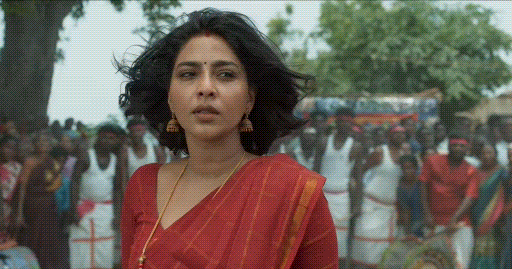






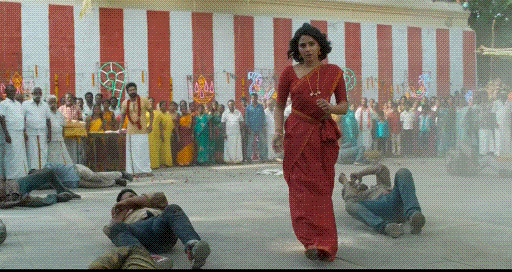
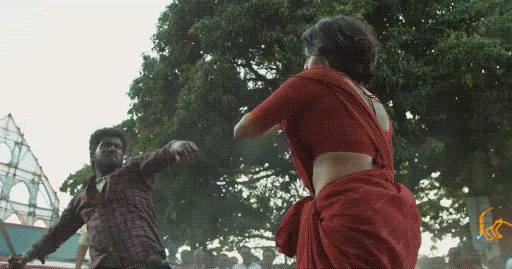
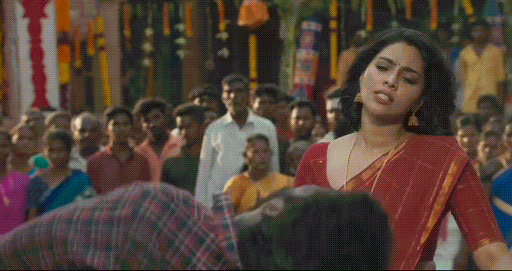

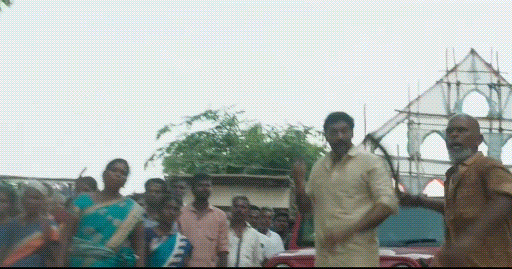







Keerthy veera level!
Bonus:
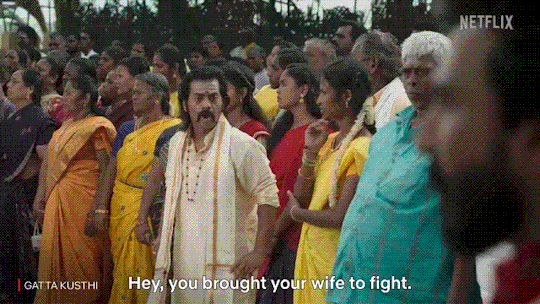

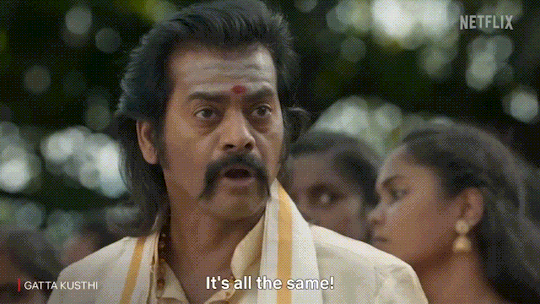
Gatta Kusthi (2022) Aishwarya Lekshmi as Keerthy Vishnu Vishal as Veera Keerthy's Fight Part 2
#kollywood#tamil cinema#gatta kusthi#wrestling#aishwarya lekshmi#vishnu vishal#lady wrestler#sports romantic comedy#sports masala action#I didn't know this was a Vishnu Vishal film because it seems that Keerthy is really our main hero even though veera made the big speech lma
23 notes
·
View notes
Text

जानिए वैष्णों देवी, नैना देवी आदि मंदिरों की स्थापना कैसे हुई?
जानने के लिए पढ़िये पवित्र सनातन धर्म के गूढ़ रहस्य बताने वाले तत्वदर्शी संत रामपाल जी महाराज जी द्वारा रचित पुस्तक "हिन्दू साहेबान! नहीं समझे गीता, वेद, पुराण।
#vaishnav#vishnu#shiva#lady shiva#सत भक्ति संदेश#saintrampaljimaharaj#sanatandharma#sanatana#sanatani#saraswati#durgamaa#devi durga#hanumanji
1 note
·
View note
Text
Happy Monday! Blessings of Lord Bhairva! సోమవారం శుభాకాంక్షలు! భైరవ భగవానుని ఆశీస్సులు!

🌹 భైరవుని భయ నివార��� శక్తి మీకు సర్వభయరహిత జీవనాన్ని ప్రసాదించాలని ప్రార్ధిస్తూ శుభ సోమవారం మిత్రులందరికి 🌹
ప్రసాద్ భరధ్వాజ
🌹 కాలభైరవుని దివ్య ఆశీస్సులతో అనుకూల కాలం మనందరి జీవితాలలో ఉండాలని కోరుకుంటూ శుభ సోమవారం మిత్రులందరికి 🌹
ప్రసాద్ భరధ్వాజ
🌹 May the power of Bhairava to eliminate fear grant you a life free from all fear. Happy Monday to all friends. 🌹
Prasad Bharadhwaj
🌹 May the divine blessings of Kala Bhairava bring favorable times in all our lives. Happy Monday to all friends. 🌹
Prasad Bharadhwaj
#సందేశాలు#message of the day#Prasad Bharadwaj#Bhairava#youtube#spiritual#insight#sanatana#sanatandharma#hindusim#hinduism#hindu gods#lord shiva#mahadev#hindustan#vishnu#shivajimaharaj#shiva#lady shiva#om namah shivay#shivablessings
0 notes
Text

🕉️ Wishing You a Blessed Maha Shivratri! 🕉️
On this auspicious occasion of Maha Shivratri, let’s seek the blessings of Lord Shiva for strength, wisdom, and inner peace. May this sacred night inspire us to embrace resilience, positivity, and the power of transformation.
Let’s take a moment to reflect, meditate, and move forward with renewed energy and purpose.
Har Har Mahadev!
Wishing you and your loved ones a Shivratri filled with devotion and divine blessings! 🙏
#MahaShivratri #HarHarMahadev #ShivratriBlessings #SpiritualWisdom #InnerStrength #postAresume #vipulMmali #vipulThewonderful
#postaresume#vipulthewonderful#vipulmmali#helpinghand#hiringnow#hiring#experttalk#linkedinlive#career#jobsearch#shivratri#mahadev#mahashivratri2025#har har mahadev#hindu#bhandara#republic day 2025#kabirisgod#hinduism#bholenath#bholebaba#shiva#lord shiva#lady shiva#om namah shivay#shivajimaharaj#brahman#vishnu
0 notes
Text
𝐒𝐩𝐫𝐢𝐧𝐠 𝐟𝐥𝐨𝐰𝐞𝐫𝐬 𝐚𝐬𝐬𝐨𝐜𝐢𝐚𝐭𝐞𝐝 𝐰𝐢𝐭𝐡 𝐝𝐞𝐢𝐭𝐢𝐞𝐬 𓇢𓆸

Peony: Asclepius, Aion, Apollo, Leto, Aphrodite
Crocus: Hermes, Brigid, Tyche, Zeus, Persephone, Hekate, Mercury, Aurora, Eos, Artemis
Asphodel: Hades, Persephone, Hekate
Columbine: Aphrodite, Venus, Freyja, Baldr
Flowering Quince: Aphrodite, Venus
Hellebore: Dionysus, Helle, Saturn, Loki, Hekate
Henbane: Hekate, Apollo, Artemis, Saturn
Pansy: Thoth, Hermes, Zeus, Venus, Aphrodite, Persephone
Dandelion: Brigid, Aphrodite, Hecate, Loki, Belenus, Hermes, Helios, Artio
Grape Hyacinth: Dionysus, Hyacinthus
Snowdrops: Brigid, Persephone, Freyja, Aphrodite, Nanna
Forget-me-not: Zeus, Freyja, Aphrodite (named „mouse ear” by her), Adonis
Magnolia: Artemis, Selene, Aphrodite, Kala
Bluebell: Selene, Hermes, Hekate
Lily of the Valley: Apollo, Asculapius, Maia, Mercury, Ostara, Skadi, Baldrr, Artemis
Primrose: Bertha, Brigid, Freyja
Hyacinth: Apollo, Zephyrus, Tyche, Hyacinthus, Quetzalcoatl, Yemaya, Dionysus
Anemone: Aphrodite, Adonis, Blodeuwedd, Artemis, Loki
Lilac: Pan, Venus, Sigyn, Dionysus
Chamomile: Tyche, Hermes, Ra, Helios, Mercury, Hestia, Oshun, Baldr, Hephaestus
Iris: Persephone, Iris, Hera, Juno, Horus, Isis
Easter Lily: Áine, Ostara
Azalea: Persephone, Artemis, Aphrodite
Tulip: Flora, Dionysus, Anahita, Eros, Lilith, Nyx
Gardenia Morpheus, Athena, Artemis, Selene
Lily: Persephone, Morrigan, Hera, Cybele, Artemis, Lilith, Thanatos
Daffodil/Narcissus: Apollo, Narcissus, Persephone, Tyche, Hades, Thanatos
Foxglove: Freyja, Flora, Juno, Dionysus, Áine, Cernunnos, Saturn
Jasmine: Lakshmi, Aphrodite, Vishnu, Selene, Morpheus, Tyche, Hermes, Hel
Wisteria: Dionysus, Hermes, Kanayago, Mercury
Larkspur (Delphinium): Apollo, Persephone, Zephyrus, Freyja, Aphrodite, Poseidon
Phlox: Eros, Demeter, Hestia, Dionysus
Poppy: Thanatos, Demeter, Ceres, Morpheus, Ares, Dionysus
Violet: Ares, Aphrodite, Io, Orpheus, Venus, Attis, Persephone, Priapus, Polukleitos , Dionysus
Carnation: Artemis, Diana, Zeus, Odin
Daisy: Brigid, Aphrodite, Freyja, Venus, Selene, Cernunnos, Hermes, Ostara
⠂⠄⠄⠂⠁⠁⠂⠄⠄⠂⠁⠁⠂⠄⠄⠂⠄⠄⠂⠂⠄⠄⠂⠁⠁⠂⠄⠄⠂⠁⠁
⠂⠄⠄⠂⠁⠁⠂⠄⠄⠂⠁⠁⠂⠄⠄⠂⠄⠄⠂⠂⠄⠄⠂⠁⠁⠂⠄⠄⠂⠁⠁
Note about this post! These aren’t all the spring flowers, just the ones I have more knowledge about and personal experience with. This list is mostly based on my own interpretation and how I’ve come to associate certain flowers with specific deities throughout my journey as a pagan witch. I’m aware there are many other deities connected to flowers, but these are the ones that came to mind while I was taking notes. I also want to mention that color is probably one of the most important aspects when it comes to associating flowers with deities. For example, Lady Athena is connected with all white flowers, Lady Aphrodite with pink ones, and Dionysus with any purple flower. Elements also play a role, flowers carry elemental energy that can deepen their symbolism or connection to a deity. There are goddesses from different religions who are patrons of flowers and vegetation, like Flora, Chloris, and others, and they’re basically associated with all flowers, so I didn’t include them here since it felt kind of obvious. Whether a flower is traditionally associated with a deity or not, I just want to say, flowers make beautiful offerings, and your deities will absolutely appreciate any plant you choose to give them :D
#greek mythology#hellenic polytheism#paganism#hellenic pagan#deity work#deity worship#witch#witchcraft#witchblr#Aphrodite#dionysus#flower#hellenic community#hellenism#hellenic#norse mythology#celtic mythology#irish mythology#spring#magic correspondences#witchy#witches#pagan witch#witch community#witchcore#hellenic paganism#pagan#pagans#paganblr#witch blog
219 notes
·
View notes
Text
The Inconsistency of Nezha's Age, a Short Introduction.
Put very bluntly, Nezha’s age varies greatly depending on which story you’re reading and who’s retold it. He is not always a child or an adult depending on retelling, though my intention here is to highlight the sheer variety available first and foremost - and perhaps shine a light on the Indian dieties which may have influenced him. If these varied images are unwanted, please keep scrolling.
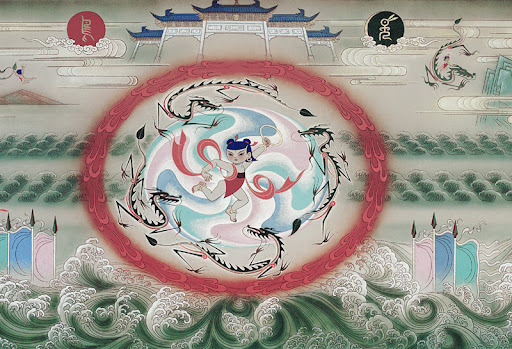
I happened to stumble upon a timeline error where Nezha’s brother Muzha is described to be using martial arts weapons referred to as “Hooks of Wu” which were specific to the 1800s, quite a long time after Canonization of the Gods was published, but also originating from a time period where numerous varied editions of that story were in circulation. Upwards of twenty different versions exclusive to the 19th century, actually.
The problem arises that Canonization of the Gods is meant to be occurring during the Zhou Shang conflict, that I will generously assume to be in 1045BCE, centuries before the Hooks of Wu would actually exist. It’s completely possible that the version Gu Zhizhong translated was one of these later editions as is makes no chronological sense for Muzha to have those kinds of weapons to begin with. So I have been on somewhat of a rabbit chase trying to pin down the edition Gu Zhizhong used.
Bearing such errors in mind, it’s easy to see where the confusion of Nezha’s age can come from. Before his origin story was integrated within Canonization of the Gods he would be roughly three to seven days old when his conflict with Ao Guang and the Lady Rock Demoness would occur - whereas within Canonization of the Gods he’s actually 6 or 7 years old.
Outside of that, a definitive age isn’t actually provided. Genuinely, within the scope of Chinese folklore and mythos it’s very rare to assign someone an exact age - which I do believe contributed heavily to the known discourse surrounding Nezha’s age to begin with.
He was imported as an adult from India, a child form not seeming to exist for a while until stories of Krsna were integrated to how the Chinese envisioned Nalakubara. Krsna, being an infantile disguise for the notorious Vishnu, also displays supernatural human strength and is actually successful in killing his father figure (1) — unlike Nezha.
As children, both Krsna and Nezha are able to wield heavenly bows and subjugate water spirits (2) while also being known to be dragon tamers (3). The inclusion of these stories to Nezha predates the sculpting of the Quanzhou Pagoda’s (which have been discussed briefly here) and are arguably the earliest evidence of Nezha being a dragon tamer.
Speculatively a child god combination of both Nalakubara and Krsna named Nana is likely where a majority of Nezha’s child attributes come from, based in the Scripture of the Supreme Secrets of Nana Deva - which would see translations within China during the Northern Song period of 960AD-1127AD. Nana would be described thus:
At that time there was a Deva called Nana. His appearance was exceptionally handsome, and his face beamed with a gentle smile. He was holding the sun, the moon, and various weapons. His numerous treasures and abundant jewelry shone more brightly than the sun and the moon. He made himself a luoye robe (4) from the dragons Nanda and Upananda, and a belt from the dragon Taksaka (5). He possessed the same strength as Narayana (i.e. Visnu). He too came to the assembly and sat down facing the Buddha … At that time the Buddha emanated great light from his dharma body of meditation. The light covered the entire Buddha Universe, reaching all the great evil yaksas, the various types of raksasas and pisacas (6) and all the evil dragons as far as the heavenly constellations. When the Buddhas light shone upon them they all awoke to the truth. The Buddhas light returned to him and, after encircling him three times, entered his head. It then reissued in seven colors from his brow, entering Nana-Deva’s head. When the Buddha light penetrated his head, Nana Deva displayed an enormous body like Mt. Sumeru. His facial expression alternated between terrifying anger and a broad smile. He had a thousand arms, and he was holding a skull (7) and numerous weapons. He was handsomely adorned with a tiger skin robe and skulls. [Mightily Strong] He emanated blazing light and terrifying strength. When Nana Deva displayed this divine body, the great earth shook, and all who beheld him were terrified.
Both Nana and Nezha share the same residence of Vaisravana’s palace, are known dragon tamers, and both were known to use belts. The Supreme Secrets of Nana Deva predate all known connections between Nezha and dragons, perhaps lending to Nezha many more elements than initially believed.
Though without concrete evidence stating one way or another, I can only present this information speculatively - especially as it seems difficult for some to understand that Nezha does enjoy a known adult and child form. This answer has already become quite long, so if there’s still confusion regarding this please feel free to ask for more details.
Bibliography:
(1) Goldman, “Fathers, Sons and Gurus,” pp.350, 364; Masson, “Childhood of Krsna”; Ramanujan, “The Indian ‘Oedipus’”; Silk, Riven by Lust, pp. 164-170.
(2) Harley, “Krishna’s Cosmic Victories”; Matchett, “Taming of Kaliya”.
(3) It’s worth comparing Matchett’s “Taming of Kaliya” p.116 with Canonization of the Gods 12.103. Nezha is five days old within the Ming era Sanjiao yuanliu shengdi fozu sou shen daquan, p. 326.
(4) Luoye is the Chinese term for a garment Indian men tied under the armpit, leaving their right shoulder bare. See Xuanzang, Da Tang Xiyu ji, T. 2087, 51: 876b, and Li Rongxi’s translation, Great Tang Dynasty Record, p.53.
(5) Nanda, Upananda, and Taksaka appear in various Buddhist lists of the eight dragon kings; see Foguang da cidian, pp. 6378,6405.
(6) The rakasas and pisacas are two types of Hindu ogres, who Buddhists demonology incorporated. Both types feed on human flesh. See Foguang da cidian, pp6673-6674 and 3851; Monier-Williams, A Sanskrit-English dictionary, pp. 871 and 628; and Strickman’s survey of Buddhist demonology in his Chinese Magical Medicine, pp. 62-68.
(7) Geboluo appears frequently within the contemporaneous Chinese translation of the Hevajra Tantra (Foshuo dabeikong zhi jin’guang dajiaowang yigui jing), no. 892 volume 18: 587-601.
(8) Zuishang mimi Nana tian jing, no. 1288, 21:358b-c. hi
#nezha#li nezha#lmk nezha#monkie kid nezha#the legend of nezha#nezha 2019#nezha reborn#nezha lego monkie kid#third lotus prince#lego monkie kid
338 notes
·
View notes
Text
Yamuna Maharani
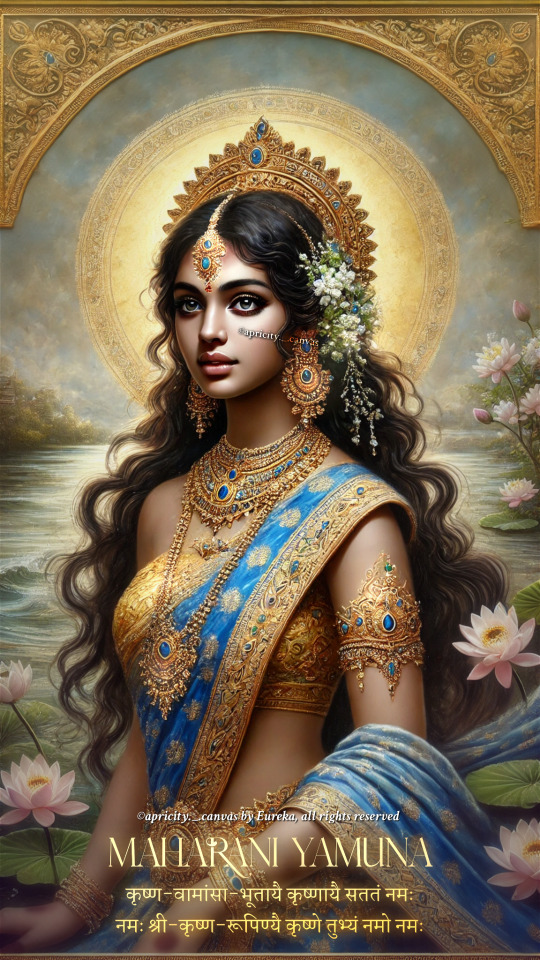
The Birth of a Divine Princess
In the golden glow of the celestial heavens, where the sun burned with divine radiance, was born a princess unlike any other. She was Kalindi, the daughter of Surya, the mighty Sun God, and Samjna, the daughter of the celestial architect Vishvakarma. Alongside her twin brother Yama, the god of death, she was destined for a path that intertwined with both mortality and eternity. From the moment of her birth, Kalindi shone with an aura of purity and grace. While her brother Yama governed the afterlife, Kalindi found herself drawn to the earthly realms, her spirit flowing like a river—both free and sacred. As time passed, she would become one with the river Yamuna, a divine entity whose waters would carry the blessings of the gods and the prayers of countless souls.

The Sacred Waters of Kalindi
Kalindi, as a river, had her source in the Kalinda Mountains, and thus she was given her name. The Yamuna River flowed parallel to the Ganges, a twin in the mortal world just as she was in birth. Yet, unlike her fair and luminous counterpart, the waters of Kalindi were dark, deep, and mysterious. The Vamana Purana tells that when Lord Shiva, grieving for his beloved Sati, leaped into her waters, the grief of the great god turned them as dark as the petals of a blue lotus. But her dark waters were not a sign of sorrow alone. They were sacred, carrying divine purification for those who bathed in them. The Padma Purana proclaims that even the most righteous of deeds—penance, charity, and sacrifice—pale in comparison to the sanctity of a single dip in Kalindi’s waters. She was not just a river; she was salvation itself.

A Princess’s Penance
Despite her celestial origins, Kalindi’s heart yearned for something more—a love that was beyond the limits of time and space. She desired Lord Vishnu, the preserver of the universe, as her husband. Determined, she descended to the mortal realm & performed severe austerities and penances, calling out to the divine. Her prayers did not go unheard. The Supreme Lord, knowing her pure heart, had already set her destiny in motion. But the moment of union was yet to come.

The Meeting of Souls
One fateful day, Arjuna, the great warrior prince of the Pandavas, and Krishna, the Supreme Being himself, were walking along the banks of Kalindi. As they wandered, Arjuna caught sight of a woman of ethereal beauty. Approaching her, he asked, “Who are you, O lady, and what brings you here in such penance?” Kalindi with a voice as gentle as flowing water, she replied, “I am Kalindi, the daughter of Surya, the keeper of these sacred waters. I have long desired to be the wife of the great Lord Vishnu, & so I wait here in prayer.” Arjuna repeated all this to Lord Vāsudeva, who was already aware of it. The Lord then took Kālindī onto His chariot and went back to see King Yudhiṣṭhira. The supremely auspicious Lord then married Kālindī on a day when the season, the lunar asterism & the configurations of the sun & other heavenly bodies were all propitious.


A Queen Amongst Queens
In Dwarka, Kalindi found herself among Krishna’s eight principal queens, the Ashta-Bharya. Yet, among them, she held a special place, for she had sought Krishna not for power, not for wealth, but for love alone. Kalindi gave birth to a pious son by name Asruta whom Madhusudana gave to Shrutasena. Having given that son away Hrishikesha delightedly said to his wife: "For long he will be the son of you both. Shrimad Bhagwatam says “Śruta, Kavi, Vṛṣa, Vīra, Subāhu, Bhadra, Śānti, Darśa and Pūrṇamāsa were sons of Kālindī. Her youngest son was Somaka.”

The Festival of Sibling Love
The love between Kalindi and her twin brother, Yama, was not forgotten. One day, Yamuna, the gentle lady of the waters, prepared a feast in golden vessels & invited Yama to dine with her on the Dvitīyā day in the month of Kārttika. Pleased with her devotion, Yama granted her a boon: “Let this day be a festival. Those who eat in their sister’s house today shall be blessed with happiness and protection.” Thus, the festival of Yama-dvitīyā (Bhai Dooj) was born—a day of love between brothers & sisters, celebrated to this very day in India.

The Eternal Goddess
As centuries passed, Kalindi’s name was spoken with reverence. Her river became a sacred pilgrimage site. Her story became a lesson in faith and love. In temples & scriptures, she is depicted riding a tortoise, holding a water pot, her complexion as dark as the depths of her sacred waters. She is no longer just the daughter of Surya or the wife of Krishna. She is Kalindi, the goddess of purity, devotion, and salvation.

The Legacy of Kalindi
Even today, the Yamuna River flows, carrying the whispers of an ancient love story. Devotees believe that those who bathe in her waters are freed from sin, that her presence is a bridge between the mortal and the divine. Kalindi’s journey—from a celestial princess to a river, a queen, and a goddess—reminds us that true love is not just about seeking, but about waiting, believing, and surrendering to the divine.

And so, as the sacred waters of Kalindi touch the earth, they carry the eternal promise: that love, in its purest form, shall always find its way home.
artist — instagram • pinterest 🌊🫧✨
#krishna#shrikrishna#krishnacore#krishnablr#hindublr#desiblr#apricitycanvas#hinduism#hindu mythology#hindugods#desiaesthetic#ashtamahishi#ashtabharya#mahabharat#mahabharata
37 notes
·
View notes
Text
🤍🤍🤍 It’s that time 🤍🤍🤍
My little Author Info page 🥺
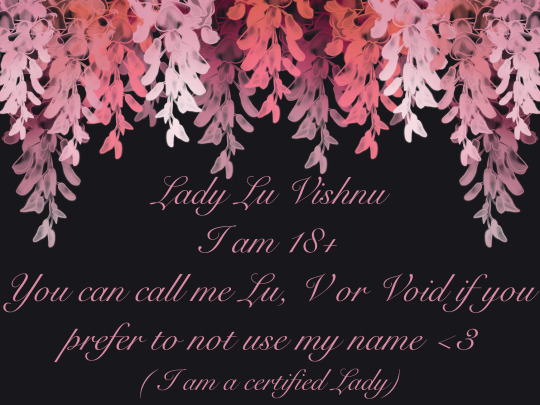

Virtually my name is Lady Lu Vishnu
Sukuna’s Wife, Toji’s Blessing, Garmadon’s Side
I don’t really care for my birth name but feel free to call me Lu, L, V or Void lol

I live on the east coast of the USA
My favorite colors are Gold, Red, Royal Blue & Black
I like 🤍Sukuna🤍,
Favorite characters aside from Kuna: Toji, Kuroo, Ushijima, Byakuya, Enji, Kyoya, Daryl Dixon 😔, Tengen, Akaza, (I can’t think my brain is sleepy)
Im Japanese Hispanic, a real mix there 😭🤍 Thanks dad and mom 🥹🤍 Im the youngest of 7
If I’m chatty I’m unfocused, If I’m focused I lock in and everything becomes irrelevant. I’m currently living in my own house and it’s rough but I like the solitude and independence, I don’t like showing my face much so here’s a collection of pictures to give everyone a rough guess of my face 🤍



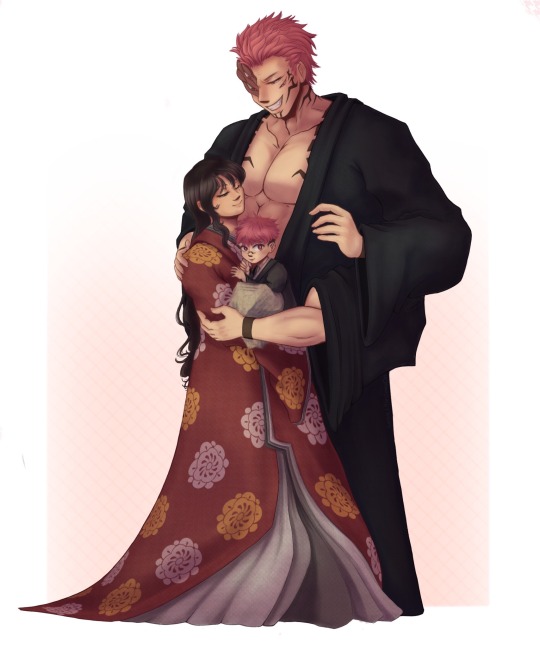

Thank you for attending my presentation 🤍 (I’ve been thinking about opening commissions for my small shop if anyone wants to support me, another post coming soon)
Tags: Perm for privilege 🥹🤍
@sakuxxi @mercymccann @certainduckanchor @najiiix @bakugou-katsukis-wife @amitiel-truth @souyasplushie @mylovelessnightmare @ynjimenez @dolliira @princessluvz @furiousblacktiger @anyaswlrd @shytastemakerthing
#sukunas wife#sukunas wife speaks#🤍mail time#sukuna ryomen#sukuna thirst#sukunation#sukuna nation#jjk commission#author info page
62 notes
·
View notes
Text
Krishna (mystery academia)
I was inspired from that old Vishnu post and that Delhi vala post so here we go. No idea how this will turn up though par dekhte hain.
No, it can't be a dream. You have pinched yourself twice, and your sister has been calling your name out from the past five minutes, but you can't help yourself. Your eyes are transfixed at that giant grey cloud hovering majestically in the sky. A face is etched on the cloud. He looks enchanting.
Your books have fallen on the floor. A mysterious flute tune rings in your ear. You haven't heard it anywhere recently, but the melodious tune starts to grow too loud. Look carefully, who is the girl in a pink saree, her golden bangles blind your vision and you hear a boy's sweet laughter before your legs give out.
It's Janmashtami night. The clock struck 12 and kids from your society broke the pot. They jump around in getting some money from the dahi handi while the adults clap and call their kids to come home. Everybody chants jai shri krishna and bows down folding their hands. You too close your eyes. Once you raise your head to look at the Krishna murti, your eyes see a person standing behind the murti, twirling a flute with his nimble fingers. Someone snaps their fingers beside your ear. The figure vanishes.
'yada yada hi dharmasya glanir bhavati bharata abhyutthanam adharmasya tadatmanam srijamyaham' Goosebumps rise on your skin and a divine vision graces your being. The sun and the stars collide, but everybody keeps breathing. The sound of a conch fills your mind and you see someone larger than any human, than any other organism on earth stand in a battlefield. He looks fierce once and then in a blink turns as calm as a river.
'paritranaya sadhunam vinashayacha dushkritam dharma sansthapanarthaya sambhavami yuge yuge' Tears flood down your eyes as you wake up from yet another dream of this all pervading misery encircling the world that has given itself to crimes and murders, forgetting that the quest for lust, greed, pride and ruthless power has gone in vain. Once again you stand on a battlefield witnessing hundreds and thousand of mighty warriors flanked by their elephants and horses. On your side stands one man. Just one man -- wielding a chakra and a large mace. He charges off at every soldier. In seconds bodies pile up on the battlefield and a guttural cry pierces your ears. The lone warrior clutches every fallen body and weeps.
The sweet smelling fragrant chandan makes you smile. The old temple priest, a gentle soul patiently applies tilak to all the devotees. After ten people comes your turn to apply the tilak. The priest's eyes brighten as if he has known you since long. You don't know him. This Krishna temple is far away from your home. The priest looks back at the beautifully decorated Krishna murti and smiles. You blink and turn your eyes to a pillar beside the garbhagriha. There stands a boy too gorgeous to be real, a form so enchanting that it etches itself on your eyes. You feel your heart thumping as the fragrant chandan clouds your senses. You are about to fall, but that lovely looking boy catches you in his arms. Flowers fall on your head and a sweet voice whispers, "Will you finally come back, sakhi?"
The night sky is full of stars tonight which is highly unusual for this busy city. Two stars gleam the brightest. You try to figure which constellation they belong too until hundreds of stars come together forming an image of a peacock feather.
At Prem Mandir in Vrindavan, you eagerly watch all the moving sculptures showing different pastimes of Krishna. Somewhere nearby, a group of ladies are singing Meerabai's songs. Your feet tap on their own accord and you feel yourself sway. When did you raise your arms to the sky and twirl? Nobody knows. Your family watches you laugh and dance in the temple. You look at no one but Krishna. The handsome boy from the temple is back again wearing bright yellow clothes -- not too hard to miss. A rough shake on your shoulders makes you open your eyes. The devotees in the temple are staring at you, but you blush in awareness of a certain dark one looking at you.
You sit gazing at the cool waters of Yamuna, the river which played an important role in Krishna's life. She saw his arrival into Gokul and his departure to Mathura. The texts and the old say that she later accompanied him as his wife to Dwaraka. You bow your head at her and dip your feet into the water. Nobody is at the ghat, it's all quiet and peaceful. Yamuna cools your body and a sense of calmness pervades your mind. You feel yourself slipping somewhere. The river like a gentle mother's touch touches your skin. "Do not fear, friend."
The car is about to cross the borders of Vrindavana. You feel your heart cry for an unknown separation. All these nights, you heard female voices whispering, "do not leave." At dawn you woke up with the sounds of a flute and sometimes your evenings were blessed with a boy gracing your hotel's terrace at sunset. He carried a peacock feather with him. You never shared a word with him nor did he with you. The steep silence yet felt comfortable.
Should I stay? Should I go? Should I call that boy and say goodbye, but how do I find him? What is this feeling in my heart? I feel it break into pieces. The driver caught your eye in the mirror and you hear a screeching break, The small flute replica hits the backside of the mirror and there you see a divine view once again.
Surrounded by cows, his feet crossed, he stands with a flute donning yellow garbs. You see the sun and the moon in his eyes. The universe gleams in his limbs. He appears magnificent. The divine sound of the conch rings again and you fall at his feet. 'I am all yours, Shyam.'
'Glad to have you back finally sakhi...' Red palms touch your forehead and the figure in front shines with bright white light like a halo around him. A lotus flower is placed on the last page of your book over Krishna's photo. The afternoon sky is now grey and far away you see a dark cloud emerging towards you.
"It shall start again, isn't it?"
Tagging the sakhis: @sanskari-kanya @shut-up-rabert @krishna-sahacharini @ketchup-jar-ka @arachneofthoughts @jessbeinme15 @ma-douce-souffrance @tumhari-bhairavi @manwalaage @inexhaustible-sources-of-magic @reallythoughtfulwizard @bambioleo @morally-gayy @krishna-priyatama @kaal-naagin
320 notes
·
View notes
Text
Saugandhika Pushpam

Saugandhika Pushpam
-Dr. Pappu Venugopala Rao
This is an exquisite composition in a Ragamalika, exploring Bheema's journey to bring beautiful flowers that Draupadi asks for.
It covers the MB episode only at a surface level, and yet the poet has used some meager words to create such a lilting scene all around us, such that I still often catch myself repeating the same words just to relish their beauty again and again!
Please forgive if you see an error in translation. <3
Himagiri saundarya hela vilaasam |
Bheema Draupadi bhavya-sringara vaasam ||
Before the beauty of the snow-clad mountains, they played.
Bheema and Draupadi played the regal game of sringara.
Vanaparva paryatana Manasija-anandam |
Vanaja-patr-ekshana vanchha-aravindam ||
In Vana Parva, while they wandered, the one born from the mind [of Vishnu, Kama] was pleased.
The one with eyes like a petal of the forest-lotus [Draupadi] expressed her desire for the divine lotus [flower].
Sumanogya sundaram saugandha-kusumam |
Anala-ja prarthayathi asamaana Bheem-am ||
Beautiful to a connoisseur of floriculture, the fragrant saugandhika-lotus, did the Fire-Born Lady [Draupadi] ask of the inimitable Bheema!
Gandhamadana gira-um langhati Vrikodara-ha |
Marga-avarodhena pashyati tam-sahodara-ha ||
While crossing the hill of Gandhamadana, the one with stomach tapered like that of a wolf [Bheema]
Came across his brother [Hanumana], who obstructed his path.
Pulaka-agra parirambha aashlishta bahu-hu |
Yuga-yugantara janita punya-metyahu-hu ||
Thus began a game of pulaka [prank], led by the one with arms strong as lightning [Hanumana],
Hearing of which shall bestow Yugas' worth of punya on the listener.
Dhana-pati parijana-parivritam nandanam |
Tatra pashyati Bheem-o adi-Gandhamaadanam ||
The Nandana-garden of the god of wealth [Kubera], surrounded by Kubera’s acquaintances [guards/yakshas]-
There entered Bheema, which [hill on which garden is present] is on Gandhamadana.
Saugandhikaa-kusuma pariplutya sanchayam |
Shata-patra-sundarim puraskritya vijayam ||
A number of saugandhika flowers did he [Bheema] gather, to the content of his heart,
And unto the lady as beautiful as a lotus with a thousand petals [Draupadi] he bestowed the credit for his victory (in bringing the flowers).
OR
And the lady as beautiful as a lotus with a thousand petals [Draupadi] felicitated his victory.
Here's a link where this composition has been beautifully presented through Bharatanatyam by Sridevi Nrithyalaya [x].
#hindu mythology#digital painting#original artwork#translation#mahabharat#draupadi#bheema#sougandhika#song translation#literature#poetry
8 notes
·
View notes
Text

Perfect Synchronicity of meme
Character of John Dorian M.D. 🐵
Character of Pepe Le Pew🙈
Character of Deadpool 🙊
Perfect Synchronicity of me lover
Chris Lake & NPC - (A drug from God)
Venus & Stupid fly - (Headless Hydra) 🙉
Green Eye of Betrothel
Irony of discord Apple and worm
Uranus Ouroboros Abracadabra👻
Perfect Synchronicity of allegiance
Muse of history with trumpet
Neptune’s Seahorse Vishnu
Wadjet - (Vulture Dean & Cobra Deena)
Perfect Synchronicity of Guardianships
Horseshoes & Grenades
Hungarian folk tales
Grand Devil Shiva Fork
Rudyraskha Shiva Tears
Anubis Tears
5 Trumpets of Environmental (Medicine, Education, Economy, Biology, Religion )
Mercury (Hermes & Caduceus)
Hekate’s (Cauldron,Torch,Canines) ☠️
Saturn’s Sickle 👻
(Ogun’s Waas) Sceptre ☠️
Gaia’s Vishnu (Biological Life experience)
Familiar Synchronicity
Athena's Aegis (the Gorgons) 👻
Characters of Rick & Morty

Presently my Favorite painting in synchronicity with me as of yesterday.———————————
Colors
1. Synthwave Gift of RetroRenaissance consisting of;
1a. Purples & Blues & Red blended with each other.
1. Wabi-Sabi Gift of RetroRenaissance consisting of
1a. Purples & Blues broken and sealed with metal, or white, or black.
2x. Hawaiian Rainbow Gothic consisting of mostly black with bright Elvis colors or Hawaiian shirts and blue genes as sign of future gift of Regeneration.
3. Gift of Regeneration of the body with;
3a. Bright (Pink , Orange ,Yellow, Green)
Philosophies
Non-Authoritarian
1a. Existential Nihilism
2. Moral & Morale
2a. Merciful code of conduct
2b. Voluntary non-duty
2c. Freedom of Sacrifice
3. Secret childhood Omni allegiances
4. Mitigating conflicts of interest concerning (purity of whole judgment of free market), (crime prevention)
4a. Avoidance of owning property
4b. Avoidance of owning intellectually property
4c. Avoidance of Investment
4d. Avoidance of compensation
4e. Avoidance of reciprocal concordance
4f. Avoidance of profit from salesmanship i.e. consultant
4g. Avoidance of lasting authorship
4h. Avoidance of owning valuable commodities
5. Mitigating liabilities.
5a. Can’t navigate a vehicle without an instructor due to safety lacking in my confidence.
5b. Avoidance of voluntary sports & Horseplay
5c. Avoidance of association while eating.
5d. Avoidance of remembering proper nouns without proper knowledge thereof.
Heroine & Hero
 Joan of Arc
 Sodom Hussain
Personal (Comforters, Cheerleaders, Spirits, Bards, Cult Artist, Sybil, Omens)
Bones & Ghosts ☠️👻
Three monkeys & Cymbals Monkey,
Greenman (Mystic tree, Mask, Door, Knocker
Moonchildrern
Personal flowers for me 🐵
Sun flowers, daffodil, tulips
Personal flowers for me’s meme 🙊
Forget me nots, Hydrangeas
Nature’s guidance
{Vultures & Snakes}, {Hawks & Eagles}, {Pink Flamingos & Blue Jays & Black Cats}
Supernatural
Unicorns, Pegasus, dragons, gorgons , Chimeras, Fairies, Gnomes, Folks AKA Moss people
Nature hidden meanings of Hekate
Dingoes, wolves, coyotes, Shepherd dogs
Sacred mercies
Nikes for witches & lesbians & slandered foreigners
intolerance to generational injustice concerning
Shorten life span, Cruel and unusual tragedies, & Deprivity of duty
Music Bands, poetic writers of lyrics, Music producers,
Black Eyed Peas, Red Hot chili peppers, Nirvana,, Depeche Mode, Mr MomMusic, Post modern jukebox, Jax Jones, Draft Punk, Spinning Songs, Red Beginois, Tom Petty, Dennis Larry, Night Club, Grimes, Tampsta, Ashnikko, NiKITA, SHLAKOBLOCHINA, Genoa White Night, Aleister Crowley, Love Craft,Die Antwoord, Shakespeare, One True God, Gotye, No Doubt,
Female singers and performers
Yelle, S3RL ,Goldfrapp,Kuary Pamyu Pamyu, Tessa Violet, Miley Cyrus, Lady Gaga, MARUV, Taylor Swift, Katy Perry, Orville Peck, Louis Armstrong, Dua Lipa,Tove Lo, Doja Cat, Kiesza,Ed Sheeran, Ava Max, Puddles Pity Party, Selena Gomez, Cara Delevingne, Bonnie Alan Watts, Pastor Arnold Murray, Yeah Yeah Yeah, Tiesto, Maroon V, Phil Collins, Rob Zombie, Little Boots, Sam Smith,
Cartoons
Pink Panther, Black Panther, ThunderCats, Yogi Bear, Care Bears, chocolate bear, vanilla bear, Bullwinkle, Pikachu, Voltron, Jetsons, Flintstones, Transformers, powder puff girls, Rick and Morty, African samurai, Beavis & Butthead, South Park, Shera, Heman, skeleton sesame Street, Muppets, bugs Bunny, Looney Tunes, Pinky & Brain, Dexter’s lab, teen titan, Hercules, Smurfs, Goofy, Pluto, Mickey Mouse, Elmer Fudd, Scooby Doo, vampire D, Akira, Disc-world, BraveStar, Star vs forces of evil, inspector gadget, Flash Gordon, Pepe Le Pew
3 notes
·
View notes
Text
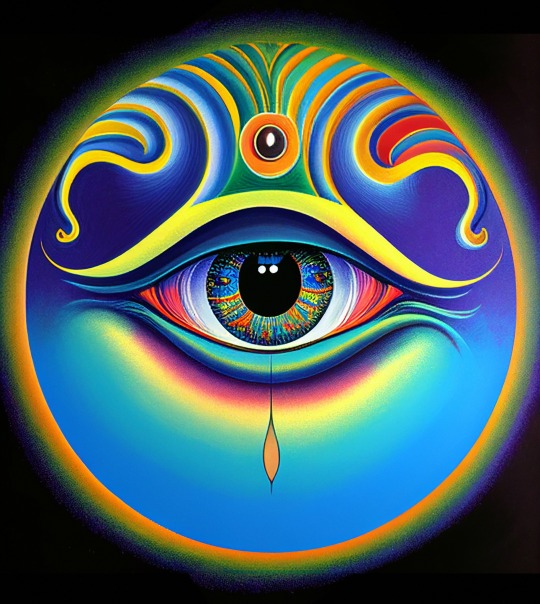

Amrita Talon Abraxas
Amrita is the nectar of immortality which was churned out of celestial ocean of milk (Kshherasagaram) by the Gods and demons. The story of getting Amrita is described in ancient Hindu scriptures. The legend has great importance in both ‘Shaivite’ and ‘Vaishnavite’ system of beliefs.
Myths of Amrita
Hindu texts explain amrita as an elixir, consumed by the Gods which made them eternal. According to the legends, four drops of the nectar fell upon earth at Ujjain, Prayag, Haridwar and Nasik. Once, there was continuous war between Gods and demons. The Gods were afraid of losing the battle. Lord Vishnu suggested them to churn the ocean of milk to get Amrita. By drinking Amrita, Gods will be immortal. Devas and Asuras (gods and demons) united their efforts to churn the ocean of milk in quest of Amrita. Gods were holding the tail of Vasuki while the demons were holding the side of the head of the serpent. Mandara Mountain was used as a churning stick and mythological serpent Vasuki was used as the churning rope.
Lord Vishnu took the form of his incarnation, ‘Koorma’ (tortoise) to hold the Mandara Mountain in place so that it does not sink into the ocean. Many precious things came out by churning the sea. Lakshmi, the Goddess of wealth emerged from the ocean and also the moon God Chandra. The divine elephant Airavata came out which was occupied by king of God, Indra. After that emerged the precious stone, ‘Kaustuva’, which Lord Vishnu had put on his chest. After all these, came the dreaded poison, ‘Kalkoota’, which was so toxic that all the creation was about to destroy. Gods and demons appealed to Lord Shiva to save them from the fumes that the poison yielded. Lord Shiva consumed the poison to save the world and retained it in his throat, which turned blue due to the effect of the poison. Henceforth, Shiva is known as the name of 'Neelakantha' or 'Vishaapaharana Murthy'.
Devasand Asuras continued with the churning of ocean after their obstacles were overcome in quest of their ultimate goal, Amrita. Finally, they got their reward when the divine physician Dhanvantariemerged out of the ocean with a pot bearing the celestial nectar of immortality or Amrita. A fierce tussle followed between the Gods and the demons regarding who will have the share of Amrita. Again Lord Vishnu took the responsibility of protecting the God. He took the guise of a beautiful charming lady named Mohini. Mohini persuaded the Asuras with her charm and served all the Amrita or ambrosia to the Gods. Thus, Lord Vishnu saved the world from the calamity that was about to take place if the Asuras had attained immortality by drinking Amrita.
Two of the Asuras were aware of the trick of Mohini. They took the guise of Gods and got a dose of Amrita. Vishnu came to know the fact and when the Asuras had consumed only half the dose of Amrita, he proceeded to destroy them. The Demons took the form of Rahu and Ketu respectively. Rahu had snake's head and human body while Ketu had human head and snake's body. Vishnu destroyed Rahu's body but his head was saved due to consuming Amrita up to the throat. It is believed that Rahu is the cause of solar and lunar eclipse as he engulfs Sun and Moon because they could see him through his guise. Another legend tells that serpent Vasuki consumed the Amrita against the wishes of sun and moon and his body was split into two demons, Rahu and Ketu and thus they became permanent enemy of sun and moon causing the eclipse.
23 notes
·
View notes
Text
Nappinnai in Ponniyin Selvan

Krishna-Nappinnai cult was prominent in Tamil-speaking areas of South India in the seventh to tenth centuries. Nappinnai can be considered a mix of Satya of Ashtabharya and Radha. This cult is the prototype of the later Radha-Krishna cult in the North. She features prominently in the poetry of Alwars (Vaishnavite poet saints) as the worldly wife of Krishna as different from the divine consorts of Lord Vishnu.
In Tamil poetry, Nappinnai is the daughter of Yashoda’s brother Kumbakan. She grew up with Krishna and Balarama and Krishna marries her by taming seven bulls in a public tournament. Nappinnai is featured in non-Hindu sources too. For example, in Jivaka Chintamani composed by the Jain saint Tirutakkatevar, a King is told that he shouldn't hesitate to marry a lower class woman because Tirumal himself is married to cowherdess Nappinnai.
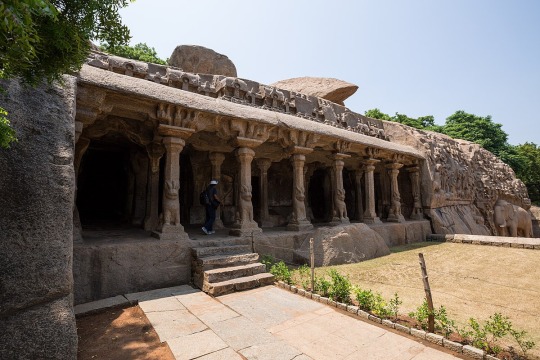
Krishna Mandapam at Mahabalipuram
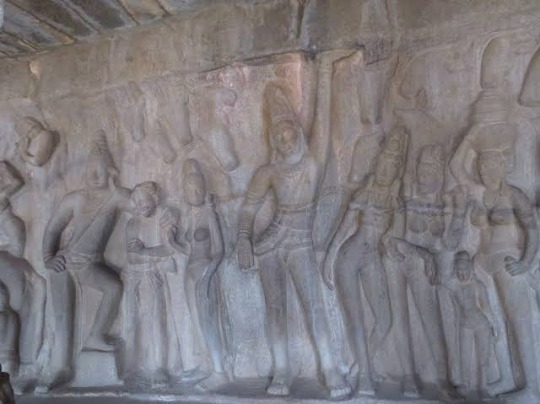
Krishnan lifting Govardhana, Balarama on the right side, consoling an old couple. Nappinnai on the left side gazing at him admiringly, holding the hands of his sister Subhadra.
Aditha Karikalan, Thirukkoilur Malayaman and Parthibendra Pallavan spend their night in this complex near the iconic Shore Temple, at the end of Book 1. The young princes discuss about sculptures and poetry, which Parthibendran finds distasteful. Malayaman leaves them to watch villu pattu in the Pancha ratha complex and it is here that Karikalan narrates the story of his heartbreak. Now it is a closed structure, but originally it was an open air bas relief. The mandapam enclosing it was constructed only in the 16th century, during Vijayanagara period.
An entire chapter (Achchiyar Kuravai) of Silappathikaram is about Nappinnai playing Kuravai dance with Krishan and Balaraman. Manimekalai (Sangham epic, not PS character) too mentions this dance. When Vanthiyathevan gives Aditha Karikalan's letter to Kundavai, Kundavai's retinue is seen dancing to this, singing about various asuras trying to kill Krishnan.
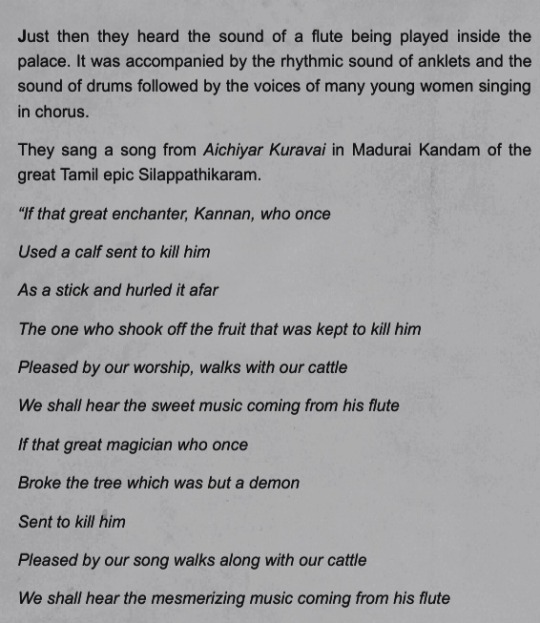
When Karikalan goes to Kadambur, there too we see the preparations for the Kuravai.
While having a heart to heart conversation (as much as someone like Nandini can open her heart), Nandini tells Manimegalai about her hallucinations. According to her, when we love or hate someone intensely, we can see and feel them even in their absence.

This is something Nandini made up for her consolation, because Nappinnai is never seperated from Krishna. In fact, it said that Vishnu left his divine wives and descended from his seat to be Nappinnai's beloved.
You parted from the eternal Great Flower [Lakshmi] and from the Lady Earth, became a youth, and then united in marriage with the shoulders of the cowherd Pinnai.
In Kuravai Koothu, women sing that Krishna avoids Lakshmi because he is so enamored by Nappinnai.
Is Pinnai of bangled arms so beautiful that He who had won great reputation by measuring the universe, would not look at Lakshmi dwelling in his own breast ?
It is to this Nappinnai that Andal prays to give her an opportunity to get one with Krishna, as her other attempts to wake him up were futile.


Nandini must have heard of the North Indian narratives about viraha unmadini (driven mad by seperation) Radha which were in their infancy then. Nappinnai didn't have the habit of seeing hallucinations - it is Nandini who has mental health issues.
This connection also shows Nandini's guilt about her life's circumstances though they were beyond her control. When Vanthiyathevan tells her that her Krishnan is still waiting for her, she replies that she doesn't deserve it. After marrying Periya Pazhuvettaraiyar, Nandini is never shown praying earnestly - either she is lying about different prayers and austerities or she is using devotion to avoid questions.
Edit: After writing the original post, I thought I will read Thirumangai Alwar's poems because his poetry is specifically mentioned in the chapter which shows Karikalan, Parthibendran and Malayaman going to the port to oversee the loading for goods for Arulmozhi's army. Look what I found:
Pinnai's forehead is a gleaming crescent moon So long ago in battle he subdued seven bulls for her hand And now he owns beautiful Kanchi which is surrounded by beautiful cool ponds of waters Where the sovereign of Pallavas who have the sharp blood stained sword in his hands Who owns a drum with a bitter mouth And the Conch with the roar of the sea Pays his obeisance to his Lord.
(The poem says that the poet's god is the Lord of Kanchi who is worshipped by the Pallava King. The rest are the descriptions of the the god and the king. In PS, crown prince Karikalan is ruling from Kanchi with Parthipendra Pallavan as his vasal)
Very subtle 🤣🤣

Are you even real, Maya Kanna?
@willkatfanfromasia @sowlspace @vibishalakshman @harinishivaa @thelekhikawrites @hollogramhallucination @thegleamingmoon @whippersnappersbookworm @nspwriteups @jukti-torko-golpo @arachneofthoughts @thirst4light
#ponniyin selvan#ponniyin selvan 2#aditha karikalan#nandini#nandhini#nandini x karikalan#kollywood#ps2#ps1
55 notes
·
View notes
Text
Dick Figures Spanish dub

Rojoberto “Rojo”: JOSÉ ANTONIO TOLEDANO
Azuluis Campos “Azul”: LUIS LEONARDO SUÁREZ
Papá-san Takagami “El Mapache”: EDUARDO FONSECA
Abeja Sintonizada Auto-máticamente: LEYLA RANGEL
Meredith P. Gurblopskey “Rosa”: JOCELYN ROBLES
Zeus/Neptuno: SEBASTIÁN LLAPUR
Stacy: MELI G
Sr. Dingleberry: JESSE CONDE
Chad Policía: DAN OSORIO (serie)/EDER LA BARRERA (película)
Lord Tourettes: MARIO FILIO
Hermáno: ALBERTO BERNAL
Pie Grande: OCTAVIO ROJAS
El Genio: RAYMUNDO ARMIJO
Artistas Callejeros: DAVID BUENO
Tedward: DAFNIS FERNÁNDEZ
Stella: TANIA BECERRA
Jason “Trollz0r”: JOSÉ ÁNGEL TORRES
Conde Gris: ANDRÉS BUSTAMANTE
Sarah Connors: ERIKA UGALDE
Medusa: ISABEL MARTIÑÓN
Jacques Bond: BETO CASTILLO
Juan BaJa: JOSÉ LUIS MIRANDA
Shi Ba: ARTURO MERCADO
Jimmy Lowe: DAN OSORIO
Gelato Bene: SALVADOR NÁJAR
Gerald Butler: SALVADOR REYES
Ninjas: CARLOS DEL CAMPO, ALEJANDRO GRAUE, y RICARDO TEJEDO
La mamá de Gelato Bene: NORIKO TAKAYA
Salchichas: CARLOS BECERRIL
Puré: ÓSCAR BONFIGLIO
Rana Robo: MARIO FILIO
Dan Avidan: RAÚL ALDANA
Robot Explorador de Marte: ALAN FERNANDO VELÁZQUEZ
Hermana de Stacy: JESSICA ÁNGELES
Narrador 1: JESÚS GUZMÁN
Matón: ARTURO MERCADO JR.
Lord Takagami: HÉCTOR ESTRADA
Guardia 1: ARTURO MERCADO
Guardia 2: RAÚL ALDANA
Trabajador Portuario 1: MIGUEL ÁNGEL RUIZ
Trabajador Portuario 2: ERICK SALINAS
Narrador 2: ENZO FORTUNY
Mujeres Japonesas: VALENTINA SOUZA
Nikos: ALEXIS ORTEGA
Robot Bailarín: AGUSTINA CIRULNIK
Colegiala Japonesa: TANIA BECERRA
Hijo-san Takagami: EDUARDO FONSECA
Esposa-san Takagami: EDUARDO FONSECa
Nieto-san Takagami: EDUARDO FONSECA
Bici: DAVID BUENO
Taxi: RICARDO MENDOZA “EL COYOTE”
Capataz de Barco TNT: EDUARDO TEJEDO
Operador de Servicios de Rescate Global: XÓCHITL UGARTE
Capitán Mayor Teniente Crookygrin: HÉCTOR LEE VARGAS
Ninja de Cumulonimbus: CARLOS DEL CAMPO
Voz de Telefono: RAÚL ANAYA
Cortador de Gueto: MARIO FILIO
Steve: VÍCTOR UGARTE
Camarera Francesa: CARLA MEDINA
Capitán DJ: MARIO FILIO
Padre Francés: OCTAVIO ROJAS
Esposa de Capitán DJ: VIOLETA ISFEL
Madre Francesa: XIMENA DE ANDA
Hijo Francés: ANGÉLICA VILLA
Policía Francés 1: RAÚL ANAYA
Vendedor de Paraguas: MARK POKORA
Cortador Francés: DAVID BUENO
Policía Francés 2: JOSÉ LUIS RIVERA
Zack Keller: RAÚL ANAYA
Ed Skudder: BENNY IBARRA
Ninja Muerto: ALEJANDRO GRAUE
Mamá-san Takagami “Sra. El Mapache”: EDUARDO FONSECA
Robin Campos “Lavanda”: LUPITA LEAL (cap. 49-51)/FERNANDA ROBLES (cap. 52-55)
Rose “Escarlata”: KARLA FALCÓN (cap. 49-51)/ALICIA BARRAGÁN (cap. 52-55)
Amandazada: KERYGMA FLORES
Jacey: ISABEL MARTIÑÓN
Sra. Dingleberry: MARÍA SANTANDER
La Mapache: EDUARDO FONSECA
Lady Tourettes: MARIO FILIO
Salmón: ALAN FERNANDO VELÁZQUEZ
Borgoña: JAVIER OLGUÍN
Director Ejecutivo Steve: JESÚS HERNÁNDEZ
El Cuellobarbudo: CARLO VÁZQUEZ
Rusty: ALAN FERNANDO VELÁZQUEZ
Vishnu: OCTAVIO ROJAS
#dick figures#dick figures the movie#chick figures#ed skudder#zack keller#redward#dick figures red#blewis n clark#dick figures blue#papa-san takagami#dick figures raccoon#lord tourettes#meredith p gurblopskey#dick figures pink#mr dingleberry#dick figures broseph#dick figures stacy#dick figures trollz0r#chick figures scarlet#chick figures lavender#auto tuned bee#lord takagami#chad cop#jacques bond#blue x pink#red x stacy’s sister
2 notes
·
View notes
Note
I understand that there are many versions of Nezha and we shouldn't stick to just one version, but I wanted to ask, does Nezha's age vary in any of the stories?
Hello!
Put very bluntly, yes, Nezha’s age varies depending on which story you’re reading and who’s retold it.
I happened to stumble upon a timeline error where Nezha’s brother Muzha is described to be using martial arts weapons referred to as “Hooks of Wu” which were specific to the 1800s, quite a long time after Canonization of the Gods was published, but also originating from a time period where numerous varied editions of that story were in circulation. Upwards of twenty different versions exclusive to the 19th century, actually.
The problem arises that Canonization of the Gods is meant to be occurring during the Zhou Shang conflict, that I will generously assume to be in 1045BCE, centuries before the Hooks of Wu would actually exist. It’s completely possible that the version Gu Zhizhong translated was one of these later editions as is makes no chronological sense for Muzha to have those kinds of weapons to begin with. So I have been on somewhat of a rabbit chase trying to pin down the edition Gu Zhizhong used.
Bearing such errors in mind, it’s easy to see where the confusion of Nezha’s age can come from. Before his origin story was integrated within Canonization of the Gods he would be roughly three to seven days old when his conflict with Ao Guang and the Lady Rock Demoness would occur - whereas within Canonization of the Gods he’s actually 6 or 7 years old.
Outside of that, a definitive age isn’t actually provided. Genuinely, within the scope of Chinese folklore and mythos it’s very rare to assign someone an exact age - which I do believe contributed heavily to the known discourse surrounding Nezha’s age to begin with.
He was imported as an adult from India, a child form not seeming to exist for a while until stories of Krsna were integrated to how the Chinese envisioned Nalakubara. Krsna, being an infantile disguise for the notorious Vishnu, also displays supernatural human strength and is actually successful in killing his father figure (1) — unlike Nezha.
As children, both Krsna and Nezha are able to wield heavenly bows and subjugate water spirits (2) while also being known to be dragon tamers (3). The inclusion of these stories to Nezha predates the sculpting of the Quanzhou Pagoda’s (which have been discussed briefly here) and are arguably the earliest evidence of Nezha being a dragon tamer.
Speculatively a child god combination of both Nalakubara and Krsna named Nana is likely where a majority of Nezha’s child attributes come from, based in the Scripture of the Supreme Secrets of Nana Deva - which would see translations within China during the Northern Song period of 960AD-1127AD. Nana would be described thus:
At that time there was a Deva called Nana. His appearance was exceptionally handsome, and his face beamed with a gentle smile. He was holding the sun, the moon, and various weapons. His numerous treasures and abundant jewelry shone more brightly than the sun and the moon. He made himself a luoye robe (4) from the dragons Nanda and Upananda, and a belt from the dragon Taksaka (5). He possessed the same strength as Narayana (i.e. Visnu). He too came to the assembly and sat down facing the Buddha … At that time the Buddha emanated great light from his dharma body of meditation. The light covered the entire Buddha Universe, reaching all the great evil yaksas, the various types of raksasas and pisacas (6) and all the evil dragons as far as the heavenly constellations. When the Buddhas light shone upon them they all awoke to the truth. The Buddhas light returned to him and, after encircling him three times, entered his head. It then reissued in seven colors from his brow, entering Nana-Deva’s head. When the Buddha light penetrated his head, Nana Deva displayed an enormous body like Mt. Sumeru. His facial expression alternated between terrifying anger and a broad smile. He had a thousand arms, and he was holding a skull (7) and numerous weapons. He was handsomely adorned with a tiger skin robe and skulls. [Mightily Strong] He emanated blazing light and terrifying strength. When Nana Deva displayed this divine body, the great earth shook, and all who beheld him were terrified.
Both Nana and Nezha share the same residence of Vaisravana’s palace, are known dragon tamers, and both were known to use belts. The Supreme Secrets of Nana Deva predate all known connections between Nezha and dragons, perhaps lending to Nezha many more elements than initially believed.
Though without concrete evidence stating one way or another, I can only present this information speculatively - especially as it seems difficult for some to understand that Nezha does enjoy a known adult and child form. This answer has already become quite long, so if there’s still confusion regarding this please feel free to ask for more details.
Bibliography:
(1) Goldman, “Fathers, Sons and Gurus,” pp.350, 364; Masson, “Childhood of Krsna”; Ramanujan, “The Indian ‘Oedipus’”; Silk, Riven by Lust, pp. 164-170.
(2) Harley, “Krishna’s Cosmic Victories”; Matchett, “Taming of Kaliya”.
(3) It’s worth comparing Matchett’s “Taming of Kaliya” p.116 with Canonization of the Gods 12.103. Nezha is five days old within the Ming era Sanjiao yuanliu shengdi fozu sou shen daquan, p. 326.
(4) Luoye is the Chinese term for a garment Indian men tied under the armpit, leaving their right shoulder bare. See Xuanzang, Da Tang Xiyu ji, T. 2087, 51: 876b, and Li Rongxi’s translation, Great Tang Dynasty Record, p.53.
(5) Nanda, Upananda, and Taksaka appear in various Buddhist lists of the eight dragon kings; see Foguang da cidian, pp. 6378,6405.
(6) The rakasas and pisacas are two types of Hindu ogres, who Buddhists demonology incorporated. Both types feed on human flesh. See Foguang da cidian, pp6673-6674 and 3851; Monier-Williams, A Sanskrit-English dictionary, pp. 871 and 628; and Strickman’s survey of Buddhist demonology in his Chinese Magical Medicine, pp. 62-68.
(7) Geboluo appears frequently within the contemporaneous Chinese translation of the Hevajra Tantra (Foshuo dabeikong zhi jin’guang dajiaowang yigui jing), no. 892 volume 18: 587-601.
(8) Zuishang mimi Nana tian jing, no. 1288, 21:358b-c. hi
#nezha#li nezha#lmk nezha#monkie kid nezha#nezha 2019#the legend of nezha#nezha lego monkie kid#third lotus prince#nalakubara#krsna#vishnu#nana deva
49 notes
·
View notes